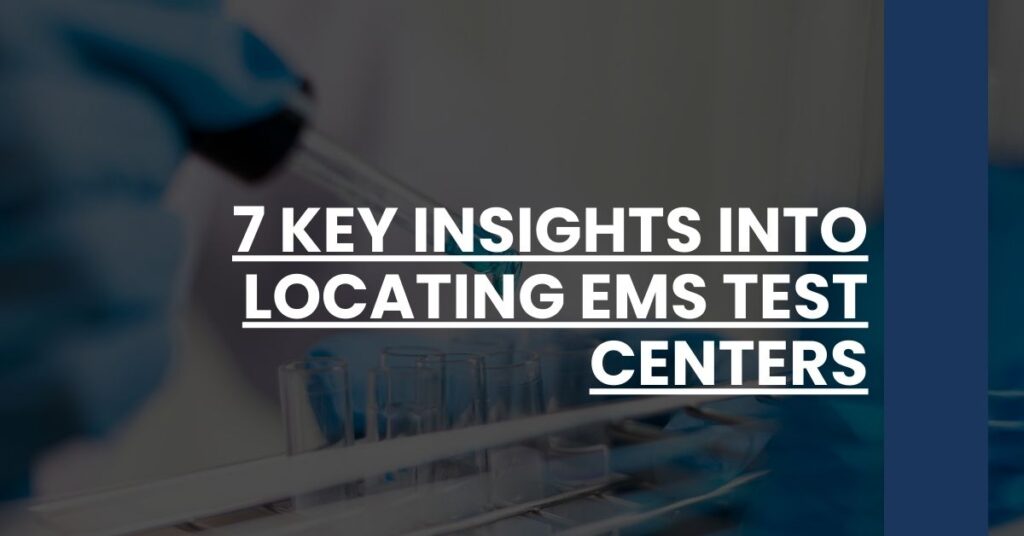When seconds count, finding the right EMS test centers quickly is critical.
But did you know that the location and the quality of the EMS exam facility can be just as crucial as acing the test itself?
Whether you’re pursuing certification or recertification, our insights ensure you won’t waste time on the wrong centers.
This guide provides clear strategies for identifying facilities that align with your career objectives, optimize convenience, and maintain rigorous standards.
- 1. Understanding National EMS Certification
- 2. Exploring Local and Statewide Testing Opportunities
- 3. Applying for Adaptive Computer Based Testing (CBT)
- 4. Navigating Exam Resources for Adequate Preparation
- 5. Innovations in EMS Examination and Test Center Development
- 6. Strategies for National EMS Certification Renewal
- 7. Insights into In-State vs. Out-of-State EMS Testing Centers
- Examining EMS Compact and Reciprocity Agreements
- Deciphering the Initial Licensure and Certification Process
- Conclusion
1. Understanding National EMS Certification
When you’re gearing up for a career in emergency medical services (EMS), the path often leads you to the critical step of obtaining national EMS certification. Before you even type “EMS test centers” into your search bar, it’s essential to appreciate the weight this certification holds.
National EMS Certification: Considered the gold standard, this certification is a testament to your preparation and proficiency in critical emergency response skills. Administered by the National Registry of Emergency Medical Technicians (NREMT), these certifications are gateways to your career, unlocking opportunities nationwide.
Choosing Your Test Center: The NREMT collaborates with Pearson VUE test centers to deliver these standardized exams. From the prospective student’s standpoint, the key is selecting a test center that not only meets the NREMT exacting standards but is also conveniently located to you. Finding a test center that aligns with your needs can be facilitated by understanding these intertwined relationships.
Prepare with Confidence: Knowing that you’ll be tested in a professional, consistent environment allows you to focus on what matters most—acing your exams.
2. Exploring Local and Statewide Testing Opportunities
As you delve into the world of EMS, you’ll quickly realize that while national certification is pivotal, local and statewide nuances can shape your experience at EMS test centers in significant ways. Each state flaunts its own requirements and approved testing sites, necessitating a tailored approach to your EMS journey.
Local Variations: Your zip code often directly influences the range of test centers available to you. Some states may have a plethora of options, while others might present a more limited selection. Get acquainted with state-specific criteria to streamline your search for the perfect testing site. For example, the Emergency Medical Services Authority details what’s required in California, shaping your strategy from the outset.
State Requirements: States like Massachusetts offer resources such as eLicensing to assist in the process, and furnish information on available NREMT test centers within the state. Your best bet is to learn these local intricacies as they’ll point you to the right EMS test center for your needs.
3. Applying for Adaptive Computer Based Testing (CBT)
The evolution of EMS exams towards Adaptive Computer Based Testing (CBT) has transformed the testing landscape, offering a personalized exam experience that adjusts to your level of competency. As you tread this path, grasping the intricacies of this format is key to your success.
Scheduling Your CBT: Registration for CBT is a streamlined process that begins with choosing from a wide spectrum of EMS test centers that facilitate this advanced form of testing. In locations like Maine, which are embracing this change, candidates are provided with abundant information on CBT and associated testing procedures.
Exam Tailored to You: What makes CBT stand apart is how the questions match your knowledge level, ensuring that each candidate’s test is unique and suited to their proficiency.
4. Navigating Exam Resources for Adequate Preparation
As an aspiring EMS professional, preparation is your best ally. Thankfully, EMS test centers often come coupled with a trove of resources designed to prepare you for exam success.
Access to Quality Materials: Arm yourself with high-quality study materials, such as those offered by Public Safety Group Learning, which provide a solid blend of textbooks and digital tools designed for EMS students. These resources give you a leg up in the preparation process, allowing you to approach your exam with confidence and clarity.
Practice Makes Perfect: Additionally, many test centers may offer practice exams and strategy sessions to help you become acclimated to the testing format and environment.
5. Innovations in EMS Examination and Test Center Development
In the pursuit of a more efficient and effective certification process, innovations in EMS examination and test center development have revolutionized how candidates approach their testing journey. It is these advancements that can be game-changers for you.
Technology Meets Testing: From virtual reality to state-of-the-art simulation labs, modern EMS test centers are integrating cutting-edge technologies to enhance the testing experience. This meshing of tech and testing means that you’re not only assessing your knowledge but also your ability to apply it in realistic scenarios.
Comfort and Convenience: The EMS examination process is increasingly focusing on the candidate experience, with test centers continually improving to offer a conducive environment for your best performance.
By staying attuned to these innovations, you can select an EMS test center that not only meets your logistical needs but also provides an enriching experience that sets you up for a bright future in the field.
6. Strategies for National EMS Certification Renewal
Your journey as an EMS professional doesn’t end with initial certification; staying current through National EMS Certification Renewal is essential. Every couple of years, you’re faced with the task of proving you still have what it takes to save lives. Here are your options—know them well.
- Invest in Continuing Education: This can be a rewarding way to fulfill recertification requirements. You can attend workshops, complete online courses, and participate in training programs—all while accumulating the Continuing Education Hours (CEH) necessary to maintain your certification.
- Recertification by Exam: Alternatively, you might choose to reaffirm your knowledge by taking the recertification exam. This option could be especially alluring if you relish the challenge of studying and excelling under test conditions. Remember to select an EMS test center that offers recertification exams; the NREMT website can point you in the right direction.
- Understand State-Specific Renewal Criteria: While national recertification is paramount, don’t forget to check if your state has additional or specific requirements. The California EMS Authority spells out a quite definitive set of criteria for Californian EMTs, for example.
Remember, staying certified is as much about proving your competency as it is about committing to ongoing education. Your choice in EMS test centers for recertification should reflect that value.
7. Insights into In-State vs. Out-of-State EMS Testing Centers
Choosing an EMS test center often comes with a geographic decision: should you stick within your state lines or venture out? Both options have their merits and potential challenges. Make your decision based on what furthers your career and fits your life.
In-State Advantages:
- Familiarity with Regulations: Close to home, you’re likely more in tune with local protocols and procedures, which can be beneficial come test day.
- Convenience and Travel Costs: Logistically speaking, you might save time and money—a boon for anyone’s budget.
- State-Specific Content: Tests could include scenarios and regulations unique to your home state, which might give you a slight edge if that’s where you’ve trained.
Out-of-State Considerations:
- Broadened Horizons: Testing outside your comfort zone can expose you to a wider range of procedures and standards.
- Reciprocity and Portability: If you’re considering working in a different state, testing there might ease the transition. EMS compact agreements play a role here; they determine if your certification can waltz across state lines.
Weighing these options helps solidify your approach to choosing the right EMS test center—one that fits your career direction and lifestyle needs.
Examining EMS Compact and Reciprocity Agreements
Navigating the nuanced landscape of EMS compact and reciprocity agreements can influence your choice of test center more than you realize. These compacts facilitate the cross-state recognition of EMS licenses, ensuring that your skills are valued beyond your home state’s borders.
- Study the Fine Print: Reciprocity varies between jurisdictions, so understanding the specifics is critical.
- Compact Member Benefits: As part of a compact, you might enjoy the flexibility of working in multiple states, easing the demand for additional certifications.
- Location, Location, Location: When selecting an EMS test center, consider if the state participates in a compact agreement. This could streamline your licensure process if you plan to offer your life-saving prowess in more than one state.
These complexities often require a thoughtful analysis but don’t be dismayed. Should interstate work be in your sights, solidifying knowledge on these compacts positions you excellently for a fluid career in EMS.
Deciphering the Initial Licensure and Certification Process
For those at the inception of their EMS careers, initial licensure and certification are the gateways to the profession. Each step of this process is integral, guiding you to your ultimate goal of becoming a certified EMS professional.
- Complete an Accredited Training Program: Your journey begins with education. Accredited programs are key in ensuring that the knowledge and skills acquired meet industry standards.
- Ace the NREMT Exam: Post-education, test centers become your next focal point. The NREMT exam is a hurdle you’ll need to clear, and choosing the right test center—one that supports your success—is pivotal.
- Meet State Requirements: Beyond national certification, state licensure is a must. Each state’s Department of Health can offer guidance here—Texas, for example, lays out the path clearly.
Finding an EMS test center well-versed in the specifics of initial certification can be a linchpin in your professional development.
Conclusion
Embarking on the search for EMS test centers isn’t just a task; it’s a significant step in your career in emergency medical services. Whether you’re at the start line awaiting your initial certification, in the throes of pursuing continued competency, or exploring the implications of reciprocity and interstate work—the choices you make here set the tone for your future.
And remember, a great EMS test center does more than administer an exam; it equips you with the confidence and convenience needed to excel in your role as an EMS professional.
Discover top EMS test centers for certification, featuring comprehensive preparation resources, state-specific guidelines, and advanced testing innovations.

